Rice fields are important greenhouse gas (GHG, CH4, and N2O) emission sources and soil organic carbon and nitrogen pools. Both GHG emission reduction and soil carbon sequestration of rice field ecosystems have always been the hotspots of soil science research. Under the background of global warming and carbon peak and carbon neutrality, the urgency and importance of ensuring high and stable grain yields while simultaneously achieving carbon sequestration and emission reduction have become increasingly prominent. To this end, the research group of Prof. Xu Hua from Institute of Soil Science, Chinese Academy of Sciences, has carried out observational studies for many years on typical single rice fields (rice-fallow, rice-wheat) and double rice fields in China. The main progress made is as follows:
Climate warming, providing much more light and heat resources for rice growth, is beneficial for single rice to planting ratoon rice, which not only increases total rice yields but also probably changes CH4 and N2O emission patterns and intensity of single rice fields. The reduction potential of CH4 emission from permanently flooded paddy fields is great in the hilly and mountainous areas of Southwest China, but the control of CH4 emission through drainage may pose a reduction in rice production. The observation results for 10 consecutive years under plastic film mulching (PM) cultivation are divided into three parts. First, PM cultivation, compared with traditional cultivation, not only changed the farming habits of continuous flooding for paddy fields, but also avoided the risk of yield reduction caused by seasonal drought, ensured high and stable rice yield, and significantly reduced irrigation water and CH4 emissions during the rice-growing season by more than 60%. Second, PM cultivation increased the average temperature of the soil surface by about 2-3°C in the rice season, which was in favor of ratoon rice cultivation. Ratoon rice could increase additional grain yield, and the advanced transplanting and fertilizing time led to the earlier peaks of CH4 and N2O emissions. The seasonal cumulative CH4 and N2O emissions increased significantly due to the application of germination-promoting and seedling fertilizers in ratoon rice and the extension of the rice observation period. Nevertheless, the integrated effects on the GHG intensity during rice season were very small. Third, compared with traditional cultivation for the whole year (Figure 1), PM significantly reduced total GHG emissions and GHG intensity by about 50%, and it increased the economic-environmental benefits by 3684 CNY ha-1 yr-1. Ratoon rice further reduced total GHG intensity, increased yield, and benefits. It has been seen that the implementation of PM cultivation in the hilly and mountainous areas of southwest China and the cultivation of ratoon rice under this technique can effectively reduce the total emissions of CH4 and N2O with high rice yields and benefits.
Elevated atmospheric CO2 concentration (e[CO2]) is important to global warming. For a long time, FACE (Free Air CO2 Enrichment) studies have shown that e[CO2] will further promote CH4 and N2O emissions from rice fields, thereby aggravating climate warming. However, based on the data of field observations and laboratory experiments from the FACE platform in Jiangdu, Yangzhou, China, for three consecutive years (the 13th-15th year of continuous increase in [CO2] during the rice season), it was found that the e[CO2] greatly reduced CH4 and N2O emissions. This reduction was that e[CO2] increased the capacity of roots oxygen secretion by promoting the growth of rice and increasing soil redox potential, so that the abundance of methanotrophs was much higher than that of methanogens, thereby reducing CH4 production while enhancing CH4 oxidation. In addition, the soil NH4+ content was significantly reduced with the rice growth. The finding was contrary to that of earlier research reports. Further global meta-analysis has found that the promotion effect of multi-year e[CO2] on CH4 and N2O emissions from paddy fields decreased significantly as the duration increased, turning from an increasing by 5.6-33% and 27-28% for <5 years and 5-10 years, respectively into a decrease of 18-43% for >10 years. Correspondingly, the total global CH4 and N2O emissions from paddy fields increased by 35-136 and 60-123 Tg CO2-eq yr-1 at first and then decreased by 22-92 Tg CO2-eq yr-1. The reasons might be the following (Figure 2): with the increase in the duration of e[CO2], its promoting effect on rice growth gradually weakened. As a result, the increase of rice yield, above-ground, and below-ground biomass declined significantly, making the increment of substrates that rice can provide to methanogens decreased largely. That resulted in the change of the ratio of methanogens abundance to methanotrophs abundance from a significant increase to a significant decrease, thus causing the ratio of CH4 production potential to CH4 oxidation potential to shift from an increase into a decrease. Besides, it promoted rice nitrogen absorption and enhanced nitrification capacity, thus greatly reducing NH4+ content in the soil. These findings provide a new perspective to accurately estimate the impact of e[CO2] on CH4 and N2O emissions from paddy fields under climate change.
Organic substitution for chemical fertilizer is one of the important means to successfully achieve the goal of " Reducing both fertilizer and pesticide " in Chinese agriculture. However, it may promote CH4 and N2O emissions and pose the risk of heavy metal pollution. There was a study of partial (25% and 50%) organic substitution (sewage sludge compost and pig manure compost) for chemical fertilizers under a rice-wheat rotation system. Compared with urea application, 25% organic substitution had no significant effect on the total emissions and GHG intensity in rice season, but it had the highest rice yield and significantly reduced Cd content in rice grains. Moreover, organic substitution significantly reduced N2O emission in wheat season and increased wheat yield, and 25% sewage sludge compost substitution significantly reduced Ni and Cd contents in wheat grains. For the whole year (Figure 3), it significantly increased soil organic carbon content by 14-20% and reduced total net global warming potential (GWP) by 115-166%, without causing soil and grain pollution and human health risks. Particularly, 50% sewage sludge compost substitution had the highest total yield, lowest net GWP, and lowest Cd content in rice and wheat grains. Since the organic fertilizer may also contain a large amount of Hg, As, organic pollutants and antibiotics, etc., the long-term application of organic fertilizer in agroecosystems may have potential risks of soil and grain pollution and human health, and related research still needs to be strengthened.
Water and fertilizer management is a key factor affecting CH4 and N2O emissions from paddy fields, and it is also an important measure to regulate soil organic carbon and nitrogen content. In China, the results of a six-year study on double-rice fields showed that (Figure 4): compared with neither drainage nor tillage), drainage or tillage after late rice harvesting significantly reduced annual CH4 emission and GWP by about 28%; under drainage conditions, tillage with straw incorporation had the highest soil carbon and nitrogen sequestration rates, the lowest net GWP, and the highest rice yield. The findings of the rice-wheat rotation system for 13 consecutive years showed that (Figure 5): compared with non-application of straw and urea, the promotion effect of straw with urea on CH4 emission increased at first and then decreased with the increase of application years, which were increased by 3.7 times at 1-2 years, 15.8 times at 6-7 years, and 7.6 times at 12-13 years; the promoting effect on N2O emission continued to increase by 3.0 times at 1-2 years, 5.2 times at 6-7 years, and 17.3 times at 12-13 years; the promoting effect on soil organic carbon sequestration rate gradually decreased with the increase of years, which were 2.7, 1.6 and 0.4 tons C ha-1 yr-1, respectively; the promotion on soil organic nitrogen sequestration rate reached the highest value in the 7th year, 57 kg N ha-1 yr-1, with the increase of years. This study can provide scientific insight into the sequestration and potential assessment of soil organic carbon and nitrogen in double-rice fields and rice-wheat rotation systems in our country.
For the typical single-rice fields and double-rice fields in China, the series of studies put forward a simple, feasible, and efficient technology model for carbon sequestration, emission reduction, high yield, and high benefits, which could provide technical means and scientific basis for the smooth implementation of the "Carbon peak and Carbon neutrality" goal in agroecosystems.
Since 2020, the results have been published in《Journal of Cleaner Production》,《Science of the Total Environment》,《Agriculture, Ecosystems and Environment》,《Field Crops Research》,《European Journal of Agronomy》,《Journal of Environmental Management》,《Science in China: Earth Science》and the other SCI journals.
Paper link: 1,2,3,4,5,6,7,8,9,10,11,12
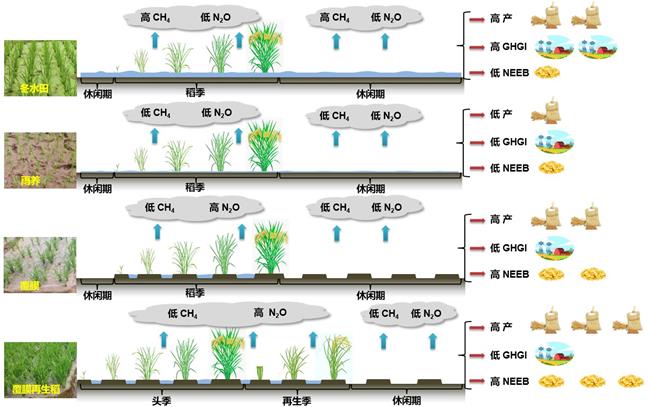 |
| Figure 1. Effects of plastic film mulching cultivation and ratoon rice planting under the cultivation on CH4 and N2O emissions, rice gain yields, GHG intensity, and economic-environmental benefits |
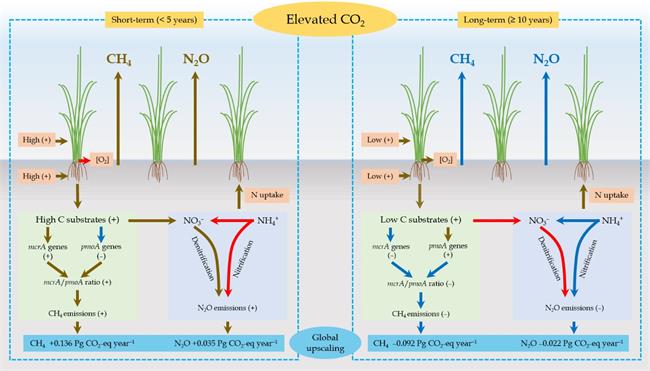 |
| Figure 2. Conceptual diagram for the mechanism analysis of the impact of an increase in e[CO2] duration on CH4 and N2O emissions from paddy fields |
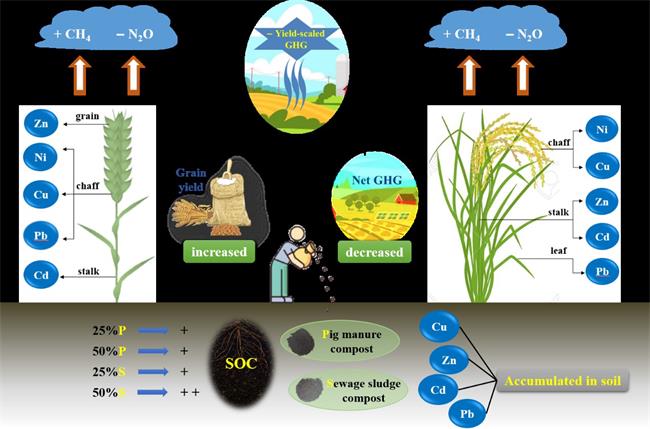 |
| Figure 3. Effects of partial organic substitution for chemical fertilizers on CH4and N2O emissions, crop yields, and heavy metal content in soil and grains
|
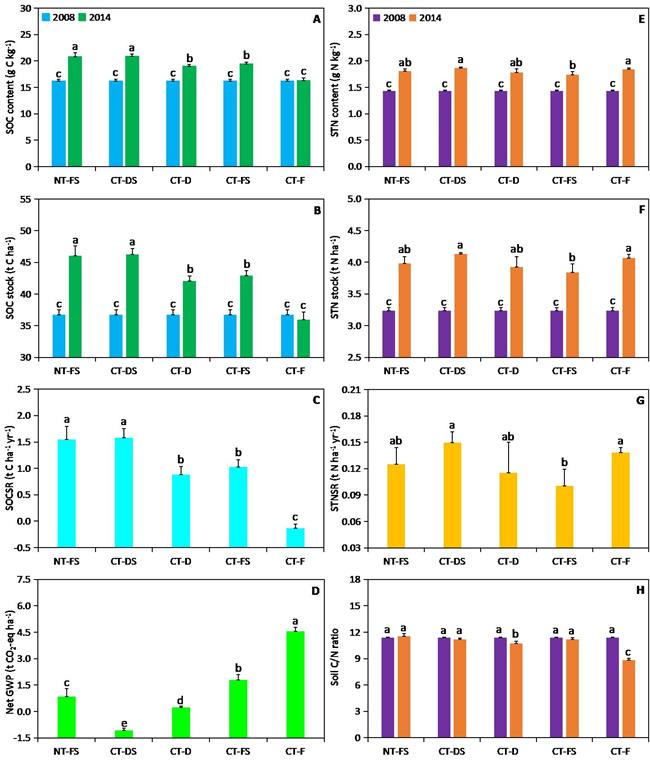 |
| Figure 4. Effects of winter drainage combined with soil tillage and straw incorporation on soil organic carbon and nitrogen in double paddy fields
|
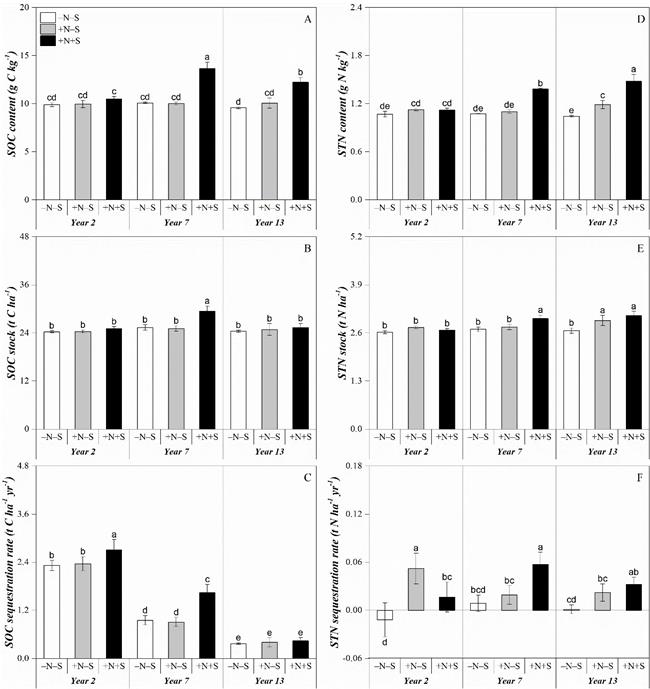 |
| Figure5. Effects of straw and urea application timing on soil organic carbon and nitrogen in the rice-wheat rotation system
|
